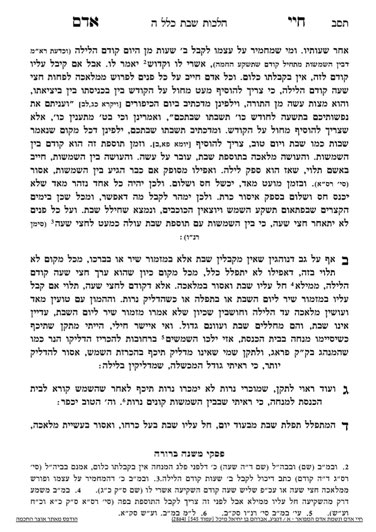We are continuing in siman 1. We left off with a contradiction in the Chayei Adam: on the one hand, he writes that the earliest one can accept Shabbos is plag (1 ¼ hours before nightfall); on the other hand, he praises one who accepts Shabbos two hours before nightfall.
One way to resolve the question is as follows. The evening period begins with shkia (sunset), ends with tzeis hakochavim (nightfall), and in between is bein hashmashos. If one performs melacha during bein hashmashos, it is a safeik whether it is yet Shabbos, and they are chayav a korban out of safeik. If one performs melacha b’meizid (on purpose) over Shabbos, they are chayav kareis, if they were warned they would be chayav misah, and if it was a shogeig they are chayav a korban chatas. When a person does an aveirah which is a safeik kareis, they are chayav an asham talui, due to the safeik issur deoraysa.
We are familiar with a famous machlokes whether bein hashmashos begins immediately after sunset, or whether it is still considered daytime after sunset, and bein hashmashos only begins in the time adjacent to nightfall. The Geonim hold that bein hashmashos begins immediately after sunset, and Rabbeinu Tam holds it begins adjacent to nightfall.
There is a third opinion, which is not as well known, but is raised by the Mishnah Berurah. This opinion, of the Yerei’eim (Rabbeinu Eliezer from Metz, one of the Baalei Tosfos), is that bein hashmashos actually begins immediately before sunset. The Mishnah Berurah explains that, in the opinion of the Yerei’im, bein hashmashos begins 18 minutes before sunset. This is one of the explanations as to why we have the minhag to light Shabbos neiros 18 minutes before sunset, in order to fulfill this opinion as well. The vast majority of opinions do not follow the Yerei’im, and therefore if one did not night 18 minutes before sunset, they can still light.
Nevertheless, if one were to follow the Yerei’im in totality, one would have to add tosefes Shabbos on top of the 18 minutes before sunset as well. In all cases of bein hashmoshos, one should never rely on the exact time printed. This is true for multiple reasons. That extra time of being careful again does not count towards tosefes Shabbos. One adds tosefes shabbos in addition to the extra time. Although we are not machmir to be concerned for his tosefes Shabbos, if one wanted to be machmir for it, they would add two to three minutes for inaccuracy of charts and clocks, and them a few extra minutes for tosefes Shabbos, in addition to the 18 minutes they already are being chosheish for. This would explain the minimum amount of time of 30 minutes suggested by the Chayei Adam.
If one adds this opinion to that of Rabbeinu Tam’s nightfall, it would come out to be close to two hours, which would explain the Chayei Adam’s suggestion of two hours. Thus, according to this explanation, the two hours suggested by the Chayei Adam applies if one takes into account both the opinion of the Yerei’im and of Rabbeinu Tam.
Summary
- One should accept Shabbos as early as they can.
- The Chayei Adam holds that one can accept Shabbos from plag hamincha (which he calculates to nightfall) or even up to two hours before nightfall.
- Minimally, the Chayei Adam holds one should accept Shabbos 30 minutes before nightfall.
- Bein hashmashos does not count towards the mitzvah of tosefes Shabbos.



